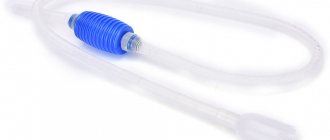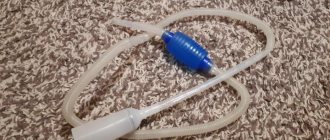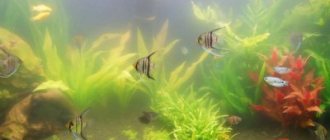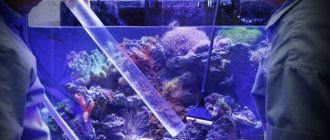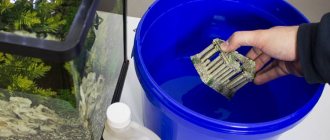Cleaning the soil from contaminants is a necessary procedure for maintaining the cleanliness of the aquarium. Today, a siphon completely copes with this task. This device can be easily purchased at any pet store or made with your own hands from scrap materials. Convenient to use and simple to set up, the siphon will completely relieve aquarists from the problems of cleaning the bottom of the reservoir.
The need to cleanse the soil
Every day a large amount of pollution settles at the bottom of the aquarium. These include sludge, food residues, plant particles and animal waste products. Over time, this debris accumulates and begins to rot, producing large numbers of dangerous bacteria that cause many diseases.
The frequency of soil siphoning directly depends on the number of inhabitants of the aquarium. The fewer fish there are in a pond, the less often the procedure needs to be carried out. On average, you need to siphon the soil once every 1.5 - 2 weeks. But this period can change both up and down, depending on the appearance of the water and the well-being of the inhabitants of the aquarium.
How to siphon soil correctly
Cleaning the soil is an important process on which the well-being of the inhabitants of the tank depends, so it is important to know how to clean an aquarium with a siphon correctly. To begin with, you should understand that cleaning will take more time - about an hour, because you will have to siphon the entire area, otherwise cleaning will not make sense. If a mechanical type device is used, the volume of drained liquid should not be more than 30%. After cleaning, the amount of drained water is compensated by fresh and clean liquid.
Large funnels are used to clean the middle of the aquarium, and triangular nozzles are suitable for the corners of the tank.
For aquariums with many plants, it is better to choose a special model of cleaners, which are sold in specialized stores, since powerful siphons powered by electricity will cause damage to the roots of the flora.
Types of siphons
Despite the fact that today you can find a large number of siphons on store shelves, all of these devices have the same operating mechanism. The only difference that divides all siphons into two groups is the type of drive: mechanical or electric. Each of them has its own disadvantages and advantages.
Mechanical siphon
A mechanical siphon consists of a tube, a hose, a glass (or funnel) and a rubber “bulb” designed for pumping out water. The principle of its operation is as follows: with the help of several clicks on the “pear”, water begins to be pumped out of the aquarium, taking with it not only debris, but also soil pebbles. Then the soil falls to the bottom, and the water, along with the debris, rises through the tube to its opposite end. At this end there should be a separate tank into which water and contaminants are drained.
The glass or funnel of such a siphon must have transparent walls. This is necessary in order to control the cleaning process and in case of any unforeseen situations (fish, snails, plants, etc. getting into the funnel) immediately stop the procedure. Also, a transparent cup allows you to understand which area is already clean and which still needs cleaning. The desired cup shape is round or oval. This form is the safest for plant roots.
Pros of using a mechanical siphon:
- Easy to operate;
- Versatile in use - suitable for any aquarium.
Disadvantages of using a mechanical siphon:
- Inability to regulate liquid pressure and flow;
- Difficulty working in places where there are a large number of plants;
- The need for an additional container into which water is drained.
Electric siphon
An electric siphon consists of a cup, a tube and a special pocket for collecting waste. This device operates on mains power or batteries. Inside such a siphon there is a special rotor that allows you to change the intensity of the water flow, which is a safer option for fish.
When the electric siphon is operating, all debris falls into a special compartment, and purified water is poured back into the aquarium through a nylon mesh.
Pros of using an electric siphon:
- Ability to adjust the power of the device;
- No need to drain water;
- Ease of use;
- No hose.
Disadvantages of using an electric siphon:
- The device can only be used in small aquariums. Because when immersed more than 50 centimeters, the water will reach the batteries and the siphon will fail.
TOP 4 best siphons
Of all the siphons currently on the market, we can safely highlight the following models.
Aquael
Made in Poland, high rating, wide range of products. Siphons from this company, in addition to soil, are also capable of cleaning aquarium glass. Structure: cylinder made of excellent quality transparent plastic; anti-kink hose; Built-in mesh to prevent foreign bodies from being sucked in. Cost – from 500 to 1000 rubles.
Tetra
World famous, large selection of high quality products. Characteristic features of siphons: a powerful valve, water drainage (up to complete pumping out), a protective mesh and other devices for a more comfortable cleaning process. Price range – from 200 to 900 rubles.
JBL
German company, products for aquariums, terrariums and even ponds in the garden. They differ from analogues in the presence of a suction power regulator. Manual siphons with check valve and quick stop button (immediate shutdown of water supply) are also available. The cost of mechanical siphons starts from 300 rubles, electric siphons - from 500 rubles.
Sera
German quality, one of the sales leaders for several decades. Transparent, durable, non-toxic plastic. Unique round shape that is ideal for large aquariums. Price – about 600 rub.
Points to pay attention to when purchasing a siphon
Having decided to purchase this device and coming to the store, you can find a large amount of this product on the shelves. In order not to make a mistake with your choice and buy exactly what you need, you should follow these tips:
- The hose of the device should have a diameter that exceeds the diameter of the aquarium pebbles by 2 - 3 millimeters. Hoses with a diameter of 8 to 12 millimeters are often used.
- The recommended material from which the hose should be made is polyvinyl chloride. It is soft, elastic and compact.
- To secure the hose, it is better to purchase additional clamps or brackets. This way it will not fall off the drain spout.
- The height of the glass must be at least 25 centimeters. Such a device will not suck in even the smallest pebbles.
What is it for?
Various models of aquarium siphons can rid the container of unwanted dirt at the bottom and provide the fish with a safe habitat. Uneaten food remains, silt and fish excrement fall to the bottom, polluting the water, causing poisoning and decreased immunity in the fish; in some breeds, the color fades and the level of activity decreases. For especially fastidious aquarium inhabitants, waste in the ground is deadly. The bottom soil should be cleaned as it gets dirty; the aquarist must carefully monitor the habitat of the pets.
Making a siphon with your own hands
Some people prefer devices made at home with their own hands to industrial siphons. This is due to the fact that such equipment has a number of advantages:
- Low cost of materials, which allows you to save on purchasing a siphon;
- No different performance;
- Quick and easy to manufacture;
- Availability of materials.
To make a siphon for an aquarium with a volume of 100 liters you will need:
- Hose. Diameter – 1 centimeter, length – 150 centimeters;
- A clean plastic water bottle (preferably mineral) with a capacity of 0.5 liters;
- Syringe with a volume of 20 cubes - 2 pieces;
- Brass outlet, the diameter of which coincides with the diameter of the hose;
- Knife.
Manufacturing process:
- Remove the syringes from the packaging, remove the needle and plunger.
- Cut one of them so that only the maximum length tube remains. Remove all protrusions.
- From the second, cut off the protrusions only on the side where the piston was placed.
- Then, in the place where the needle was attached, make a round hole with a diameter of about 10 millimeters.
- Connect the syringes at the ends without protrusions and secure them with electrical tape. The hole made earlier should be located at the end of the resulting tube.
- You need to place a hose in this hole and also secure it with electrical tape.
- Trim the plastic bottle at the bottom where the bends begin.
- Make a hole in the bottle cap with a diameter of no more than 1 centimeter (about 8 - 9 millimeters).
- Insert the brass outlet into this hole and attach its other end to the hose.
- Place the cap on the bottle.
The siphon is ready. The cost of manufacturing such a device, depending on the materials used, does not exceed 160 rubles.
Structure and principle of operation
A siphon for aquariums, acting like a dropper, is a long transparent hose, to which a wider tube is attached at one end, and at the other - a traction device (similar to a vacuum cleaner) with the ability to drain contaminated liquid. The first part is a glass, a cylindrical funnel (with a diameter of at least 5 cm) or any other suction or receiving device. The second is a special pump, a bulb, or simply the open end of a tube, through which you can independently provoke the outflow of air from the system by inhaling.
Storage and maintenance
In order for the siphon to work for a long time and perform its duties efficiently, it is important not only to purchase a good model or make a suitable device, but also to store it correctly.
After using the siphon, it must be disassembled and all parts must be thoroughly washed with soapy water or a special detergent with an environmentally friendly composition. Next, they need to be thoroughly wiped or dried well. It is better to store unassembled.
The siphon undoubtedly plays a big role in maintaining the cleanliness of an artificial reservoir and preserving the health of its inhabitants. Every aquarist should have this device. Having studied all its varieties and instructions for making it yourself, you can, based on your preferences, choose a suitable device that protects the cleanliness of the aquarium.
Popular and trusted brands
Manufacturers of equipment for artificial reservoirs offer a wide range of devices for cleaning aquariums to suit every taste and budget. The main thing when choosing a soil cleaner is to calmly and thoughtfully consider each model, assessing the advantages and disadvantages. Well, if there is no opportunity to purchase models from popular brands, then you can make a siphon for an aquarium with your own hands.
How is cleaning done?
You should use the siphon a few weeks after starting the aquarium, not earlier. Firstly, there will be no point in the procedure, since organic matter and food residues have not yet had time to accumulate. Secondly, the inhabitants of the aquarium are just getting accustomed to their new place, therefore, it is not advisable to disturb them.
The cleaning process, in addition to removing excess organic matter settled on the ground, involves removing part of the water. In some cases, it is filtered and returned back, in others it is simpler and topped up with clean water to the desired level.
Cleaning procedure:
- Prepare a siphon and a container for water (a regular bucket will do).
- Fill the siphon tube with water and immerse it in the aquarium. The free end must be lowered below the bottom level, otherwise the water will not flow by gravity (if an electric siphon model is used, this condition is not necessary).
- It is recommended to conditionally divide the bottom area into squares in advance so that cleaning is as thorough as possible. This especially applies to large aquariums.
- Using a tube, lightly stir up the soil, raising the turbidity. It is recommended to immerse it to the very bottom (to the glass) in order to siphon the entire layer of backfill and remove organic matter with maximum efficiency.
- Heavier soil particles will settle to the bottom, and organic matter and fine suspension will be picked up by the water flow and discharged into the prepared container.
- The process is controlled by monitoring the state of the flow. As soon as the water in the tube has become clear, the procedure is transferred to the next section of the bottom (or stopped altogether).
The more powerful the siphon, the larger the tube diameter required. If the water leaves too intensively, the soil itself may be sucked in, which is undesirable. It is necessary to organize the process so that only organic matter and suspended matter are removed, and the backfill layer remains at the bottom.
How to choose the right model
How to clean? The manipulations are not complicated. The main thing is to choose the right unit for these purposes. The volume of the existing tank plays an important role in the product selection process. The same can be said about the number of inhabitants and their parameters.
It is better to give preference to electrical devices. They are more convenient to use. Their operation does not require experience or special knowledge. It is enough to carefully read the instructions supplied by the manufacturer and fully comply with them when carrying out manipulations.
The diameter of the hose is important. It should not be too large, as there is a possibility of pebbles and small inhabitants being drawn inside. It is better to buy a transparent hose. It will allow you to monitor the presence or absence of blockages, and will help to carry out proper cleaning, preventing undesirable consequences. The best option is a hose made of durable plastic. It is lightweight, flexible, easy to use, strong and durable.
You need to choose the right nozzles for siphons. It is better to purchase a kit containing devices with different parameters. Large ones can be used to clean the middle of the tank, small triangular ones will help tidy up corners and process decorations.
Rating of the best mechanical soil cleaners for aquariums
Sera 26015108
This mechanical soil cleaner allows you to quickly and effectively get rid of small debris that has accumulated inside the container with fish. Able to cope with large inclusions, without the risk of harm to the inhabitants. It is enough to replace half the fluid, which is convenient if there are a large number of residents. Externally, the product looks simple, but in practice it shows excellent efficiency. Subsequent maintenance of the device is simple, as is the operation process itself. There is a bulb inside, which eliminates the risk of liquid leakage during pumping.
Average price – 2154 rubles.
soil cleaner Sera 26015108
Advantages:
- economical and effective device;
- ease of use;
- low maintenance requirements;
- unlimited service life;
- German build quality.
Flaws:
- not identified.
LAGUNA 29570174
This device is designed to completely clean a water tank from small debris and sand. It copes well with sediment even in hard-to-reach places. The design consists of a hose and an intake-type tube. To regulate the water flow, the manufacturer installed a special tap. No additional effort is required to draw water into the tube. A special filter is also installed, which eliminates the risk of soil, fish and plants getting into the system. The hose length is 2 m, which allows you to process tanks of any size. High-strength plastic is used for manufacturing.
Cost – 1950 rubles.
soil cleaner LAGUNA 29570174
Advantages:
- simplicity of design;
- unlimited service life;
- possibility of complete cleaning of the container;
- there is no need to completely drain the water.
Flaws:
- not identified.
Aleas 16681207
This device is designed for processing small tanks with fish. The design is equipped with a special valve, which is responsible for pumping liquid. In order to start the process, you need to place the flask in the water column and shake the product several times up and down with a sharp movement. The hose is made of high-quality material that is not afraid of creases. The manufacturer has installed a removable tip, which has a cone shape. Helps quickly and effectively get rid of accumulated dirt. The length of the hose is 1.5 m. High-strength plastic is used to make the body.
How much does the design cost? The purchase will cost 1620 rubles.
soil cleaner Aleas 16681207
Advantages:
- unlimited service life;
- ease of subsequent use;
- simplicity of design;
- low maintenance requirements;
- safety (for residents).
Flaws:
- not identified.
Ferrum-Aqua 25861962
This device will become an indispensable assistant for every aquarium owner, without exception. Suitable for cleaning tanks of any size. With its help, the user can easily collect leftover food, waste from the inhabitants and other debris from the container. Does an excellent job of cleaning the top layer of soil. Due to the built-in filter, fish and decorative elements are not in danger. There is a plastic tube between the nozzle and the hose. The manufacturer also provides a bulb, which eliminates the risk of additional manipulations for pumping water into the system. Hose length – 2 m.
Average price – 982 rubles.
soil cleaner Ferrum-Aqua 25861962
Advantages:
- ease of use;
- can be used on a regular basis;
- low maintenance requirements;
- polyvinyl chloride is used to make the case;
- comfortable pear.
Flaws:
- not identified.
Battery Powered Aquarium Gravel
264 Reviews 563 orders(s)
Specifications: Condition: 100% Brand New Material: Plastic Color: As shown in the picture Power Source: 2 x 1.5 VC batteries (not included) Drain Pipe Length: Approx. 67cm/26.38in Intake Pipe Length (3pcs): Approx. 18cm/7.09in, 20cm/7.87in, 40cm/15.75in Total length: min. 58cm/22.83in, 72cm/28.35in. 95cm/37.40in (adjustable) Normal water level: 30cm. Water level: 72 cm. : 520L/h Weight: approx. 373 g
Package Included: 1 x Gravel Cleaner Main Body (Battery Not Included) 3 x Water Inlet Pipes 1 x Drainage Pipe 1 x Strainer Bag 1 x Blackhead and Pimple Remover Tool 1 x Cleaning Brush;
Note: 1. Please allow 0-2cm differs due to manual measurement. Thanks for understanding. 2. Monitors are not calibrated same, item color displayed in photos may be slightly different from the actual item.
Price: 650.05 rub.
BUY ON ALIEXPRESS
Frequently asked questions
Let's consider some questions that novice aquarists constantly have regarding the procedure for cleaning the soil with a siphon:
Do I need to remove driftwood and other decorative elements before cleaning?
It is not advisable to touch snags. If access to some areas is difficult, it is recommended to use a special funnel attachment with a curved and thinner tube.
Do I need to remove the fish before using the siphon?
No, there is no need to remove the inhabitants of the aquarium, but you must act carefully, trying to protect the fish from getting inside the funnel.
When can you siphon an aquarium for the first time?
No earlier than 14 days after launch (in practice, this period is often extended to a month or more).
How to reduce the frequency of soil cleaning?
To reduce the frequency of cleaning, it is recommended to reduce the number of fish and plant the aquarium with plants with a strong root system. In such conditions, you can do without using a siphon altogether.
What should be done if the siphon does not absorb water well?
You can increase suction by changing the diameter of the funnel. The smaller it is, the greater the water suction force. However, you should not reduce the size of the funnel too much, otherwise it will begin to draw in soil.
How to visually determine that it is time to siphon the soil?
Rotten plant roots indicate the need for cleaning. In addition, you can perform a test using a stick immersed in the ground. If gas bubbles come out of it, then it’s time to siphon the aquarium.
Cleaning an aquarium using a siphon allows you to quickly and without special preparation remove waste and food residues that have settled on the ground. The procedure is quite simple and does not require the use of complex equipment - you can make a siphon yourself.
There are some contraindications that you need to know about in advance (using a siphon in herbalists or cleaning soils). A correctly performed procedure will allow you to establish a comfortable habitat for the fish and eliminate the bad smell from the aquarium.
Methods for cleaning the soil in an aquarium using a siphon, as well as practical tips
When keeping any type of aquarium fish and other animals, it is important to keep the aquarium clean. Proper and timely cleaning of the soil and water in the aquarium is one of the integral components of caring for swimming pets.
Which type is better
A siphon is an accessory that is difficult for any aquarium owner to do without. All the inhabitants of the aquarium release their waste products into the environment, the decomposition of which can release rotting products - poisonous gases hydrogen sulfide and ammonia.
Important! These gases are harmful to all living organisms in the aquarium.
If in large natural reservoirs this does not have a significant impact on the health of fish and other animals, then in an aquarium, even a large one, the soil must be regularly cleaned of bottom sediments - fish excrement and silt. In this way, you can clean the filler in the form of sand, pebbles, black types and other varieties.
Pros and cons of using a siphon for an aquarium
The positive aspects of cleaning soil using a siphon include:
- the ability to remove decaying organic particles;
- the danger of acidification of the substrate, which does not receive oxygen, is eliminated;
- the bad odor is eliminated, no harmful gases are released from the soil.
Flaws:
- the number of bacteria living in the upper layers of the substrate decreases, which leads to a decrease in biofiltration ability;
- Nutrients are removed from the soil, which worsens the conditions for keeping plants;
- there is a risk of damage to the roots of aquatic plants.
When choosing a method for cleaning an aquarium, you need to weigh all the pros and cons so as not to disturb the ecosystem and not worsen the living conditions of fish and other organisms.
Soil cleaning methods
Two main methods are used to clean soil:
- using a dirt suction device (or siphon);
- removing soil from the aquarium and placing it in a specially selected container, followed by rinsing under running water.
As a rule, the first cleaning option is used because it is less labor-intensive and does not take much time. You can extend the procedure over several days by dividing the bottom area into sections and sequentially treating one or two per day.
Cleaning with soil extraction requires greater efficiency, since the fish are temporarily resettled and are in unusual conditions. This can greatly harm the inhabitants of the aquarium, therefore, they try to complete the cleaning procedure as soon as possible.
Manufacturing materials
In the modern world, the production of such devices from several materials has been established, each of which has its own positive and negative sides.
Plastic siphons are becoming more popular today. This popularity is achieved due to the low cost of the products and their good performance characteristics. By the way, siphons made of plastic are very light, but they are endowed with high strength. It is important that such siphons can be cleaned with chemicals, since they are impervious to chemical influences. Another advantage is the ease of installation of such a product, regardless of the installation location
Among other things, plastic resists the formation of limescale, which is important; Siphons made of non-ferrous metals (bronze/copper). Every person has an idea of what a siphon is, so there is no point in talking about the negative aspects of copper and bronze here
It is clear that non-ferrous metals require considerable effort to keep them in a presentable form. However, if there is a specific design in the room, the overall stylistic decision may require the installation of just such siphons, because plastic or brass products can stand out from the general range and violate the style; Brass siphons are currently the most expensive. The chrome coating of this product allows it to harmonize perfectly with other interior elements made of brass and metal, for example, a dryer. Brass requires due respect, so its care must be careful, while its performance characteristics leave much to be desired. It is worth saying that siphons made of brass have increased fragility.
When not to siphon
- Rarely do they clean aquariums that are completely planted and contain small amounts of small fish and shrimp. The absence of acidification is due to the fact that plant roots penetrate all layers of soil and release oxygen. The released oxygen eliminates the formation of anaerobic zones. The exception is small and weak roots in combination with fine soil laid out in a thick layer. To control the situation, you should periodically check the soil, loosening it with a thin stick.
- It is forbidden to siphon a newly launched aquarium; it will be possible to siphon it no earlier than after 14 days. It is necessary to first grow a colony of nitrifying bacteria in the reservoir; only water changes are allowed.
- It is prohibited to use a siphon to clean herbal aquariums that are densely planted. The siphon will upset the balance, depriving the plant roots of the necessary nutrition. Cleaning helps to raise sludge, which releases harmful substances into the water, including ammonium. Another feature of the herbalist is the nutrient substrates, which are washed away during cleaning, losing their benefits.
What to do to clean the soil less often
An aquarist does not always have time to clean his home pond. You won’t have to siphon the bottom often if you follow the following recommendations:
- Correctly calculate the number of fish for certain dimensions of a reservoir. If there is a lot of organic matter, the aquarium is probably overcrowded.
- Plant plants with a branched root system that need more nutrients. They will process fish waste products.
- Reduce the layer to 3 cm so that plant roots can penetrate deep without hindrance.
- Organize the feeding diet of aquatic inhabitants. Do not overfeed, make sure that the fish eat the food completely, as uneaten food greatly pollutes the environment.
- Introduce aquarium snails. They are not just beautiful. Many types of snails actively eat food debris, rotting plant stems and other debris, and clean the tank walls and decorative elements. Thus, they help reduce the level of toxins in the aquatic environment.
There is a rule: one-dimensional particles (no matter whether large or small) do not cake and are less susceptible to souring. You will be able to clean the bottom of the aquarium much less often if you follow most of these recommendations.
